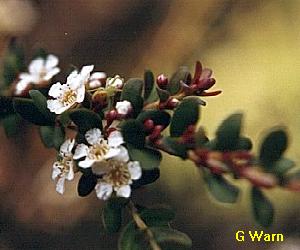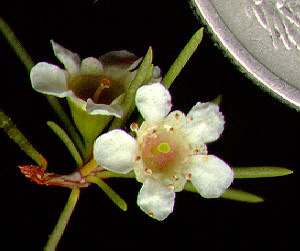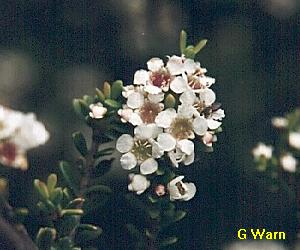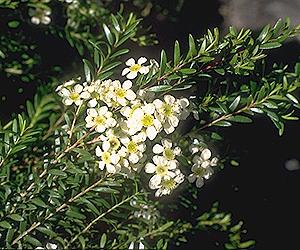|
[Front Page] [Features] [Departments] [Society Home] [Subscribe]

When is a Baeckea not a Baeckea?
Merren Sloane
When it's a Babingtonia or a Triplarina or even an Ochrosperma or an Euryomyrtus!
George Bentham in 1867 established a broad concept for the genus Baeckea but in recent years studies have shown that, because of differences in the group, many Baeckea species should be placed into other genera. There have been several papers published recognising five genera in eastern Australia, New Caledonia and Malesia - Ochrosperma, Triplarina, Babingtonia, Baeckea and Euryomyrtus.
M.E. Trudgen's 1987 paper introduces the new genus Ochrosperma and A.R. Bean of the Queensland Herbarium has published papers detailing three genera, Triplarina, Babingtonia and the now restricted Baeckea (1997,1999). Bean's papers include a key to the five genera, as well as keys to species and botanical descriptions, distribution maps and notes on habitat. In 2001, Trudgen reinstated and revised the genus Euryomyrtus.
Scope
This article covers those species of Ochrosperma, Triplarina, Babingtonia, Baeckea and Euryomyrtus currently recognised for eastern Australia (Queensland, New South Wales, Victoria, Tasmania).
Ochrosperma
In his 1987 paper, Trudgen placed three Baeckea species into the new genus, Ochrosperma. In 1995 and 1997, Bean expanded and revised Trudgen's work recognising 6 species in the genus, 5 occurring in eastern Australia.
| Species of Ochrosperma in Eastern Australia |
| New Name | Former Name |
| Ochrosperma adpressum | Baeckea sp 'Mt Minda' |
| Ochrosperma citriodorum | Baeckea citriodora |
| Ochrosperma lineare | Baeckea linearis |
| Ochrosperma oligomerum | Ochrosperma monticola; Baeckea sp 'B' |
| New Species | |
| Ochrosperma obovatum | |
|
Triplarina
 |
|
| Triplarina volcanica subsp.volcanica is common in cultivation as Baeckea camphorata. Photo: Geoff Warn. |
|
In 1995 A.R. Bean placed some species of Baeckea previously placed in Baeckea camphorata into a reinstated genus Triplarina.
Triplarina is an endemic Australian genus containing seven species in New South Wales and Queensland, occurring mainly in sheltered positions on shady slopes, gorges or creek banks; all except T.paludosa within 80km of the coast.
| Species of Triplarina in Eastern Australia |
| New Name | Former Name |
| Triplarina imbricata | Baeckea camphorata R. Br. ex Sims |
| Triplarina nowraensis | Baeckea camphorata (as illustrated in Flora of NSW) |
| Triplarina paludosa | Baeckea sp 'Stony Creek Falls' |
| Triplarina volcanica | Consists of 2 subspecies:
subsp. volcanica - this is the only species in cultivation (mis-named as Baeckea camphorata)
subsp. borealis - known from only a few locations from the Wide Bay District, Queensland |
| New Species | |
| Triplarina bancroftii | Restricted distribution in south-east Queensland. |
| Triplarina calophylla | Known only from 2 localities near Bowen, Queensland. |
| Triplarina nitchaga | Known only from 2 localities in the Ravenshoe area, Queensland. |
|
Babingtonia
A.R. Bean in 1997 reinstated the genus Babingtonia for a large group of species previously included in Baeckea. Babingtonia was named by Lindley in 1842. Twelve species are listed for eastern Australia, including Babingtonia virgata which is a complex species - see the separate review of this species below.
 |
 |
Babingtonia tozerensis (left) is still often seen as Baeckea sp. "Mt Tozer". (Photo: Geoff Warn).
Babingtonia densifolia (right - Photo: Geoff Warn). |
Babingtonia species are found on hill and mountain sides on shallow soils, though some species allied to B.virgata live in deeper soil on creek banks and in valleys. None are found in swampy sites.
| Species of Babingtonia in Eastern Australia |
| New Name | Former Name |
| Babingtonia behrii | Baeckea behrii R. Br. ex Sims |
| Babingtonia crenulata | Baeckea crenulata/Baeckea crenatifolia |
| Babingtonia cunninghamii | Baeckea cunninghamii |
| Babingtonia densifolia | Baeckea densifolia |
| Babingtonia jucunda | Baeckea jucunda |
| Babingtonia squarrulosa | Baeckea squarrulosa |
| Babingtonia tozerensis | Baeckea sp 'Mt Tozer' |
| Babingtonia virgata complex | Baeckea virgata |
| New Species | |
| Babingtonia granitica | |
| Babingtonia odontocalyx | |
| Babingtonia prominens | |
| Babingtonia silvestris | |
|
Baeckea
In 1997, A.R. Bean published another paper (Telopea 7(3), 1997) concerning the species in eastern Australia, Malesia and south-east Asia now remaining in the genus Baeckea and describing three new species from Queensland and NSW.
There are twelve Baeckea species in eastern Australia with one of these, B.frutescens extending through Malesia to southern China.
Baeckea are usually found in swamps and heathlands, though B.brevifolia and B.kandos are found on sandstone rocks.
 |
 |
Baeckea stenophylla (left) is now included in B.frutescens (Photo: © Greg Steenbeeke. Sourced from The Plants Directory CD-ROM).
Baeckea utilis (right - Photo: Geoff Warn). |
| Species of Baeckea in Eastern Australia |
| Species still called Baeckea | Former Name |
| Baeckea brevifolia | Baeckea brevifolia |
| Baeckea diosmifolia | Baeckea diosmifolia |
| Baeckea frutescens | Baeckea frutescens, includes B.stenophylla |
| Baeckea gunniana | Baeckea gunniana var. gunniana |
| Baeckea imbricata | Baeckea imbricata |
| Baeckea latifolia | Baeckea gunniana var. latifolia |
| Baeckea leptocaulis | Baeckea leptocaulis |
| Baeckea linifolia | Baeckea linifolia |
| Baeckea utilis | Baeckea utilis |
| New Species | |
| Baeckea kandos | |
| Baeckea omissa | |
| Baeckea trapezaa | |
|
Euryomyrtus
 |
|
| Euryomyrtus ramosissima subsp.ramosissima is a popular species in cultivation. Photo: Ivan Margitta. |
|
M.E. Trudgen in 2001 reinstated and revised the genus Euryomyrtus which consists of 7 species, two of which are found in eastern Australia. In addition to several new species, the revision places the well known species formerly known as Baeckea ramosissima into Euryomyrtus.
| Species of Euryomyrtus in Eastern Australia |
| New Name | Former Name |
| Euryomyrtus denticulata | Baeckea denticulata. |
| Euryomyrtus ramosissima | Baeckea ramosissima.
Consists of 2 subspecies: subsp. ramosissima and subsp. prostrata. |
|
The Babingtonia virgata Complex
The group of plants previously known as Baeckea (now Babingtonia) virgata occurs in many parts of eastern Australia and is well-known in cultivation, with many forms and varieties. In his recently published study of the Babingtonia virgata complex, A.R. Bean has examined many specimens of naturally occurring plants from eastern Australia and the New Caledonia region.
 |
|
| The popular cultivar known as Baeckea virgata (dwarf form) is a rounded shrub to about 1 metre in height. Its taxonomic status as a result of Bean's revision is unclear. Photo: Brian Walters. |
|
The shrub known as Babingtonia virgata was first collected in New Caledonia in 1774. Bean considers this species to be different from the Australian members of the complex and proposes that the name Babingtonia virgata be restricted to this species, found only in New Caledonia and neighbouring islands.
So, naturally occurring Australian plants until now included in Babingtonia virgata must be placed into new species. Bean describes eight Australian species, acknowledging the difficulty of separating them since there is considerable intergrading over distances of 50-100 kilometres in some areas.
They are shrubs with small leaves and small white flowers, mainly in summer, occurring variously on creek banks, in eucalypt forest or on rocky outcrops, always on sandy or skeletal soils with low nutrients. The eight Australian species Bean proposes are:
- Babingtonia angusta - a shrub to 2.5m high, which occurs in two areas:
- North Queensland from Townsville to Atherton, and
- From south-eastern Queensland to north-eastern NSW.
A selected form is in cultivation as Baeckea sp 'Clarence River'.
- Babingtonia bidwillii - a shrub or small tree to 5m high, occurring in coastal areas of Queensland from Shoalwater Bay (north of Rockhampton) to just north of Brisbane.
- Babingtonia brachypoda - a shrub to 4m high, found in a few sites in Queensland - Rolleston, Woorabinda, Theodore.
- Babingtonia collina - a shrub to 3m high, in eastern areas of NSW and Queensland from Dorrigo to Yandina with some isolated populations further north.
- Babingtonia crassa - a shrub to 2.5m high, in the eastern end of the Northern Tablelands of NSW, from east of Armidale to Barrington Tops. Conservation status - 'Priority for Investigation'.
- Babingtonia papillosa - a shrub to 1.5m high, known only in two populations (20 plants in one and 2 plants in the other), both in Bowling Green Bay National Park, south of Townsville. Conservation status - 'Critical'.
- Babingtonia pluriflora - a shrub to 4m high, in the south-eastern coastal areas and adjacent ranges, from Port Stephens, NSW to Bairnsdale, Vic. Originally named Camphoromyrtus pluriflora by Mueller in 1855. Specimens from the Budawang range in southern NSW have very short leaves and may prove to be distinct.
- Babingtonia similis - a shrub to 2m high, from the Brisbane area to near Newcastle, NSW.
Bean's article includes full botanical descriptions of the eight species, and of B.virgata for comparison, with distribution maps and a figure comparing the size and shape of their leaves. He also publishes keys to all eastern Australian Babingtonia species and to the Australian members of the B.virgata group.
The challenge remains to fit the commonly available varieties and forms into these eight species.
References
- M.E. Trudgen, 1987. Ochrosperma, a new genus of Myrtaceae (Leptospermeae, Baeckeae) from NSW and Queensland, Nuytsia 6(1): 9-17.
- A.R. Bean, 1995. Reinstatement and revision of Triplarina Raf. (Myrtaceae), Austrobaileya 4(3): 353-367.
- A.R. Bean, 1997. Reinstatement of the genus Babingtonia Lindl. (Myrtaceae, Leptospermoideae), Austrobaileya 4(4): 627-645.
- A.R. Bean, 1997. A revision of Baeckea (Myrtaceae) in eastern Australia, Malesia and south-east Asia. Telopea 7(3): 245-268.
- A.R. Bean, 1999. A revision of the Babingtonia virgata (J.R. Forst. and G. Forst.) F. Muell. complex (Myrtaceae) in Australia, Austrobaileya 5(2): 157-171.
- M.E. Trudgen, 2001. Reinstatement and revision of Euryomyrtus (Myrtaceae), Nuytsia 13(3).
This article is based on two articles published in the journal of the Canberra Region of the Society for Growing Australian Plants in September 1999 and September 2000. The material has been updated by Brian Walters, in consultation with Merren, to include the recent work by Trudgen on the genus Euryomyrtus and other minor amendments.

[Front Page] [Features] [Departments] [Society Home] [Subscribe]
Australian Plants online - December 2001
Association of Societies for Growing Australian Plants
|